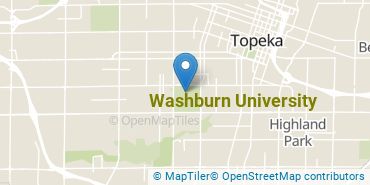Washburn University Overview
Located in Topeka, Kansas, Washburn University is a public institution. The city atmosphere of Topeka makes it a great place for students who enjoy having lots of educational and entertainment options.
What Is Washburn University Known For?
- Although it may not be available for every major, the doctor's degree is the highest award a student can attain at Washburn University.
- In a recent academic period62% of the faculty were full-time.
- A student who earns a bachelor's degree from Washburn University makes roughly $49,774 a year. This is 22% more than their peers from other colleges and universities.
Where Is Washburn University?

Contact details for Washburn University are given below.
| Contact Details | |
|---|---|
| Address: | 1700 Sw College Avenue, Topeka, KS 66621 |
| Phone: | 785-670-1010 |
| Website: | www.washburn.edu |
How Do I Get Into Washburn University?
You can apply to Washburn University online at: www.washburn.edu/admissions/apply.html
Can I Afford Washburn University?
The net price is calculated by adding tuition, room, board and other costs and subtracting financial aid.
Student Loan Debt
It's not uncommon for college students to take out loans to pay for school. In fact, almost 66% of students nationwide depend at least partially on loans. At Washburn University, approximately 41% of students took out student loans averaging $5,496 a year. That adds up to $21,984 over four years for those students.
Explore Best Ranked Schools for You
Washburn University Undergraduate Student Diversity

There are also 810 graduate students at the school.
Gender Diversity
Of the 3,326 full-time undergraduates at Washburn University, 38% are male and 62% are female.

Racial-Ethnic Diversity
The racial-ethnic breakdown of Washburn University students is as follows.

| Race/Ethnicity | Number of Grads |
|---|---|
| Asian | 55 |
| Black or African American | 210 |
| Hispanic or Latino | 420 |
| White | 2,241 |
| International Students | 114 |
| Other Races/Ethnicities | 286 |
Geographic Diversity
Kansas students aren't the only ones who study at Washburn University. At this time, 20 states are represented by the student population at the school.
Over 44 countries are represented at Washburn University. The most popular countries sending students to the school are China, Saudi Arabia, and Japan.
Washburn University Undergraduate Concentrations
The table below shows the number of awards for each concentration.
References
*The racial-ethnic minorities count is calculated by taking the total number of students and subtracting white students, international students, and students whose race/ethnicity was unknown. This number is then divided by the total number of students at the school to obtain the racial-ethnic minorities percentage.
- College Factual
- National Center for Education Statistics
- Image Credit: By Marion Doss under License
More about our data sources and methodologies.
